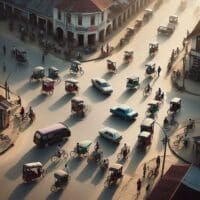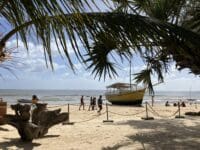Travel diary, part 2: Toliara and Mangily
Maeva* is an intern at ADES and is currently writing her Master's thesis in Madagascar. She gives us an insight into her experiences.


So far, I really like Toliara. You can tell that it's a city by the sea, because although the actual sea access itself is rather industrial and partly surrounded by mangroves, the ground is often sandy, lots of fresh seafood is on offer and it's significantly warmer than in the highlands. When we land in Toliara at around 7 a.m. after our 5 a.m. flight, it is sunny and warm. After being picked up in a Karenji, the very cool local Malagasy car, and settling into our hotel, Luc and I walk to the ADES office here in Toliara. On the way there, we both stand out, both rather pale from the Swiss winter and Tana's overcast sky. Quite a few people turn round after us Vazahs, who are travelling on foot. I hear a few "eeh Princesse", and Luc turns to them several times, beaming and thanking them for the compliment. Everyone is grinning and we arrive at the office a good 20 minutes later, already a little sweaty. The Direction Nationale is located here in Toliara, and in addition to various administrative departments, IT and finance, there is also the test laboratory and the workshop for manufacturing various cookers (solar, as well as clay). When we arrive, I am amazed! The centre is beautiful, full of plants, buildings with warm colours, a large square with a basketball hoop in ADES colours, large containers in which the warehouse is located and open, bright workshops for the metal and wood workshop. The welcome round is also extensive and everyone is incredibly friendly. Angelphine (who is also responsible for tourist visits and the secretariat) takes us on a tour and we are allowed to look everywhere. What I like most is Fara, the cook, who seems to be able to prepare everything on the solar or energy-saving cookers!

The first arrival in Toliara was short. We arrived on Thursday, and at the weekend Luc and I travelled from Friday evening to Sunday afternoon to Mangily, a small village about an hour away by the sea. The water was really bath tub temperature, and the beach was beautiful! It was also great to watch the pirogues coming and going, either for excursions with tourists or for fishing. They always came back with huge lobsters in shimmering shades of turquoise and orange, and antennae that were almost like thorns on the sides and about as long as my arm.
What you quickly notice is the rope barrier that divides the beach between the hotel and the sea into two halves. The hotel side is reserved for hotel guests and also marks the area where all the women selling scarves, plaits, face masks and massages as well as children selling necklaces, wooden animals or shells, or the fishermen selling pirogue trips or lobsters or coconuts are not allowed to cross. It's a bit strange. Of course, you're always asked, and as soon as you're spotted, you're off. At first, I wasn't quite sure whether I should just lie down on a deckchair in a bikini on the upper side of the line, while four children stand on the other side, always shouting "Madame", or the women sitting in the bright sun are also always looking for eye contact. Eventually I walked past the line to the sea to look for shells, dip my feet in the water and go for a walk. It wasn't long before I was surrounded by children. After some back and forth, I was able to distract them a little from the sale by starting to look for crabs and fish, they taught me some Malagasy, and over the next few days we went swimming, played ninja, built sand mermaids and waved to each other from afar.

Back in Toliara, we walk to the ADES centre every morning, work in the conference room and walk back every evening. At some point I discovered the word for "walk" in Malagasy, and now when pousse-pousse drivers call out to us asking if we need a lift, I reply: "tsia (no), zangazanga!" As the week progresses, we find out that the food at the Moringa Hotel, where we are staying, is really not to be recommended. I also hadn't found a solution for lunch at the beginning, as almost everyone here either goes home, has something with them or, like Luc, doesn't eat. On the first two days, I walked around the neighbourhood and bought some cooked manioc from a stall - which was either extremely tasty - or I was extremely hungry. I got to know Charline and her little sister, who live behind the blue door a few metres from the entrance to ADES. She went out to buy manioc at the same time as me, so I joined her without further ado. This resulted in several small encounters and finally even an incredibly sweet letter, and I look forward to seeing her again when I travel to Toliara again in June. But back to the question of lunch: as I quickly realised after my second meal of manioc, it wasn't quite so recommendable for my Vazah stomach in the long run. But I was lucky: on the third day, Fara took pity on me. I met her when she was cooking the "znüni" for the workers and asked her if I could have some of it if there was anything left over. From then on, she reserved me a plate every lunchtime with either some more Vary bred (rice in water with vegetables), pasta, fried potato balls (or something) and once even freshly fried Zébu kebabs on the parabolic solar cooker!
* Name changed

